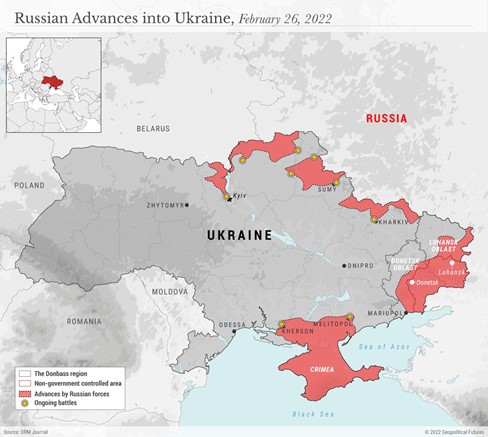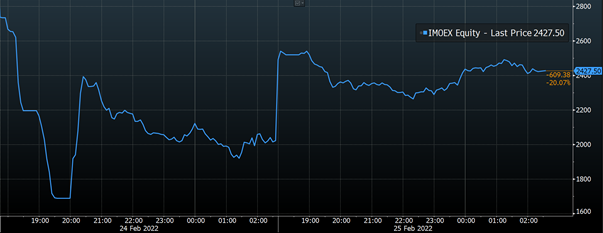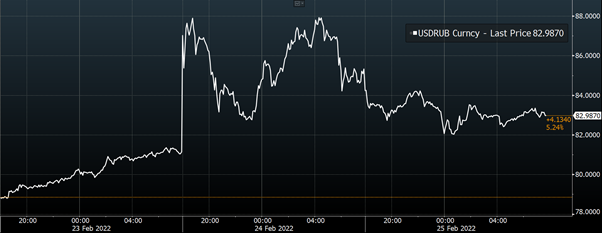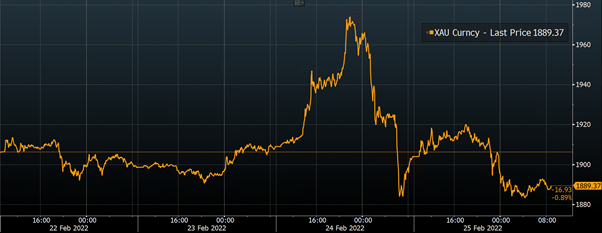Last Thursday morning (local time), Vladimir Putin launched a broad-based Russian military offensive against Ukraine – with the intention to “demilitarise” and “denazify” the country.
Whilst his true objectives may be worlds apart from this line of reasoning, it does not change the severity of the situation – where we are in the midst of witnessing a widespread invasion of Europe’s second-largest country by landmass (only behind Russia), populated by approximately 44.1 million people.
As it stands, it appears that this will be largest armed conflict in Europe since WW2, and has currently involved missile, air and artillery strikes throughout Ukraine, as well as ground incursions by Russian forces via Belarus, Western Russia, Crimea and the Donbass region (red highlighted areas in the graphic below).
What started as an incursion into the more pro-Russian Donbass region – where Russian separatists have been in constant conflict with Ukrainian forces for years – it has now developed into a countrywide invasion from multiple angles, going far beyond what most expected.

Source: Geopolitical Futures
Given the ‘fog of war’ which is currently present, it is difficult to understand the situation with absolute certainty – however, we do know the following facts (as of the writing of this note on 27-Feb-22):
- Russian forces have launched a 3-prong invasion from the north, east and south – targeting Kyiv, Kharkiv and Kherson respectively.
- Ukrainian President Zelenskyy stated that 137 Ukrainians have died on the first day of fighting, with their armed forces destroying 30 Russian tanks, 130 armoured fighting vehicles, 5 aircraft and 6 helicopters. Over the next two days, there has been further casualties, although no official figures have been reported.
- Russia has taken several key strategic locations in areas surrounding Kyiv, including Chernobyl and several air bases, and have begun to enter Kyiv, as well as surrounding the city of Kharkiv
- Ukraine and Russia have begun consulting on a time and place for negotiations regarding a cease-fire and peace talks
On top of this, Ukrainian men aged between the 16 and 60 have been banned from leaving the country, with President Zelenskyy also guaranteeing that all citizens wishing to receive a gun can do so – with many lining up in Kyiv for their government issued Kalashnikovs (AK-47s and others of the same make but different model).
The Ukrainian Ministry of Internal Affairs has also released images on Telegram, instructing its civilians on how to make a Molotov cocktail – comparing their fight to the Finnish guerrillas who managed to defeat the Soviet Union in 1940 during the famous “Winter War”.
Russian actions have been met with international condemnation, with the application of economic sanctions making up the bulk of the pain for the Kremlin.
How Heavy Are the Sanctions?
As was advertised during the months prior to invasion, retaliation from western nations has primarily come in the form of heavy economic sanctions against Russian financial institutions, military-linked companies, and notable individuals.
After much debate, western leaders have agreed upon excluding “selected” Russian banks from the SWIFT network – although the US have stated that they will work with the SWIFT to identify any payments used for energy, and to allow those payments to proceed.
These measures were finally passed as the countries more dependent on Russia’s energy were able to have assurances that their flows of energy would not be disrupted – with German finance minister Christian Lindner stating that “necessary deliveries of raw materials should not be disrupted by the move”.
Within this announcement, restrictions were also imposed on the Russian Central Bank from deploying its international currency reserves in a way which undermines sanctions – effectively removing their ability to support the ruble with their ~USD$600bn worth in currency reserves, severely restricting the flow of imports and exports, and likely promoting inflation.
In earlier sanctions, the assets of financial/military linked institutions and notable individuals were frozen, as well as restrictions placed on their ability to transact and travel outside of their domestic borders.
Russian oligarchs have also been targeted – both due to their connections to Putin, but also in the hopes that they will lobby to bring conflict to a halt.
The largest talking point going into this conflict was the potential impact on global energy markets, where investors feared of supply side disruptions further exasperating inflationary pressures.
Whilst Nord Stream 2 has been put on hold as expected, no major sanctions have been placed on energy producing companies, with oil also continuing to flow through Ukrainian pipelines without issues for the time being.
Western nations have not slowed their purchasing of energy resources from Russia over the past few days, where their unhealthy dependence on Russian energy will likely preclude their ability to hamstring Russia’s most important exports.
“Our measures were not designed to disrupt, in any way, the current flow of energy from Russia to the world”
- Daleep Singh, Deputy National Security Advisor for International Economics
Countries like Germany are most conflicted for the time being, with Economic Minister Robert Habeck calling for reduced dependence on the nation, given Germany sources 50% of their coal, 55% of their gas and 35% of their oil from Russia.
How Have Markets Reacted?
Russian markets plummeted in the hours after the invasion was announced – with the Russian equity index (MOEX) falling approximately 45% and the ruble losing approximately 8% against the USD. Both have since recovered slightly but will remain under pressure for the foreseeable future as the impact of economic sanctions takes hold.
Chart 1: MOEX 3-Day Performance

Source: Bloomberg, as at 25-Feb-22
Chart 2: USDRUB 3-Day Performance

Source: Bloomberg, as at 25-Feb-22
Developed Market Performance
| Bond Yields | Close (25/2) | Thursday (bps) | Friday (bps) |
| US 10-year | 1.96% | -2.6 | -0.2 |
| German Bund 10-year | 0.23% | -5.7 | +6.0 |
| UK Gilt 10-year | 1.46% | -3.2 | +1.0 |
| Australian 10-year | 2.23% | -11.3 | +7.5 |
Source: Bloomberg, as at 25-Feb-22
| Market | Close (25/2) | Thursday (%) | Friday (%) |
| S&P 500 | 4,384.65 | 1.50% | 2.24% |
| NASDAQ | 13,694.62 | 3.34% | 1.64% |
| FTSE 100 | 7,489.46 | -3.88% | 3.91% |
| DAX | 14,567.23 | -3.96% | 3.67% |
| STOX 600 | 3,970.69 | -3.63% | 3.69% |
| ASX200 | 6,997.81 | -2.98% | 0.10% |
| AUDJPY | 83.55 | -0.53% | 0.96% |
| USDJPY | 115.55 | 0.45% | 0.02% |
| EURUSD | 1.13 | -1.02% | 0.68% |
| Gold | 1,889.34 | -0.27% | -0.76% |
| Silver | 24.27 | -1.36% | 0.23% |
| Brent Crude | 97.93 | 2.31% | -1.16% |
| Natural Gas | 4.47 | -1.19% | -2.15% |
| Bitcoin | 38,994.50 | 2.32% | 1.51% |
Source: Bloomberg, as at 25-Feb-22
Within developed markets, investor reactions were mixed over the two days since the invasion commenced.
Thursday saw kneejerk reactions, with investors rushing to the safety of government bonds and gold, as well as many investors exiting European equity exposures.
However, by the end of Thursday’s trading sessions, most gains/losses had moderated, with gold giving up the entirety of its 3% rally.
Chart 3: Gold (USD) 3-Day Performance

Source: Bloomberg, as at 25-Feb-22
On Friday, global investors were much more inclined to take on risk as the picture surrounding economic sanctions and the geopolitical landscape became clearer.
Growth stocks also performed well over the 2-day period, as investors tempered expectations for a 50bp rate hike in the March Fed meeting – instead anticipating that the Fed will take a more dovish tone for the time being.
As we discussed in last week’s note, the implications of conflict will be primarily restricted to those markets/commodities which have close ties to the region – with this point so far holding up.
Have Markets Seen the Worst of It?
Global dependence on Russian oil and natural gas has proven to mitigate any major upward pressure on commodity prices for now, and will likely continue to be the case as western nations deal with the unfortunate balancing act between looking out for the wellbeing of the Ukrainian people, and the health of their own economies.
Disruptions to energy supply chains would likely only eventuate as a result of Russian intervention, or damage in Ukrainian pipeline networks, given the stance adopted by Western nations against sanctioning the energy sector.
Such a disruption would cause significant volatility in commodity prices, although predicting such an event is extremely difficult.
Global power dynamics in oil and natural gas markets are unlikely to change in the coming months, given the inability of other nations to compensate for Russia’s contributions – with a focus on clean energy transitions leaving western nations chronically underinvested into fossil fuel technologies, at a time where they are still critical to energy infrastructure.
Should commodity prices remain contained, Australian and US equity markets will likely continue to remain relatively unaffected by the conflict, given the lack of economic ties to the region.
The views expressed in this article are the views of the stated author as at the date published and are subject to change based on markets and other conditions. Past performance is not a reliable indicator of future performance. Mason Stevens is only providing general advice in providing this information. You should consider this information, along with all your other investments and strategies when assessing the appropriateness of the information to your individual circumstances. Mason Stevens and its associates and their respective directors and other staff each declare that they may hold interests in securities and/or earn fees or other benefits from transactions arising as a result of information contained in this article.



